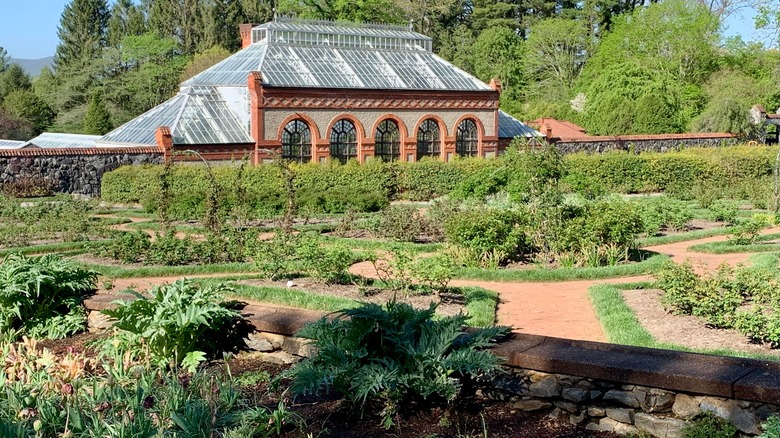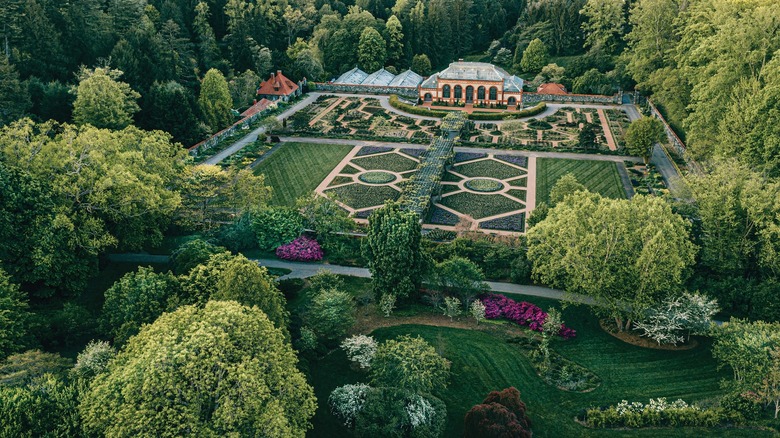The Beautiful And Historic North Carolina Garden HGTV Is Calling The Best In The State
Tourists with a horticultural inclination may be surprised to know that the most visited garden in North Carolina isn't a botanical garden or arboretum, but rather, a private home. The Biltmore Estate's gardens boast this esteemed distinction, and HGTV considers it the most beautiful garden in the state. Attracting 1.4 million people a year with its 8000 acres and 250-room castle — there's certainly a lot of Biltmore to love.
Travelers to Western North Carolina and the Blue Ridge Parkway often include this destination on their trip agenda because there's so much to do and see there, from horseback riding, to visiting the grounds and house. That last term may be misleading — the Biltmore House is actually an impressive French Renaissance style chateau brimming with historical objects and art — not to mention the 175,000 square feet of gorgeous interior and exterior architecture. But the grounds are what particularly entrance many of the visitors to Biltmore.
What makes the landscaping at Biltmore Estate so special
The estate is now considered a National Historic Landmark, confirming the site's rich history along side its beauty. The Biltmore Estate's gardens were created for the Vanderbilt family in Asheville, North Carolina in 1895 by Frederick Law Olmsted, the same landscape architect who designed Central Park in New York City. Olmstead designed a landscape where color and texture were at the forefront all year long and a hardworking team helps keep the original vision alive today.
It's not surprising that HGTV singled out this location as being the most beautiful horticultural site in North Carolina. The grounds include 75 acres of landscaped gardens, with the bulk of the Estate's 8,000 acres being devoted to managed forests. There are both natural areas and formal designs that represent a fusion of French and English style landscaping. Also included are a 10-acre shrub garden, 15-acre azalea garden, a walled garden, and 22 miles of trails. Throughout the grounds, water features provide reflections of local vegetation and hardscaping frames the surrounding Blue Ridge Mountain landscape. And nestled into the gardens, a conservatory provides visitors opportunities to gaze upon orchids, cacti, and palms.
Take inspiration from Biltmore's gardens in your own yard
It's hard to leave the historic Biltmore Estate's gardens without feeling inspired to breathe the same type of artistry into our own yards. Many of us can borrow the idea of terracing from the site to create different levels, which makes a tiny yard look much more spacious. Although the formal gardens at Biltmore incorporate large doses of symmetry, be careful about going overboard with that in your own yard, since it's a landscape design trend that's rather outdated now. If you use formal areas with symmetrical plantings in your yard, border them with more natural areas to keep things cozy.
With Western NC and the Blue Ridge Parkway being famous for fall color, it's no surprise that the caretakers of the grounds continue to highlight autumn foliage. You can use some of the same shrubs found in the grounds, such as Carolina allspice (Calycanthus floridus) and oakleaf hydrangeas (Hydrangea quercifolia) to provide fall color. And don't forget to emulate Olmstead's design by planning for visual interest during the cold months with plants that will bring color to your yard during drab winters. Above all, start small and keep things manageable when taking inspiration from this gorgeous site for your own yard. The Biltmore Estate employs over 2,000 people to keep the house and grounds looking beautiful all year long, so we can only aspire to a smidgeon of the beauty offered by this incredible destination.


